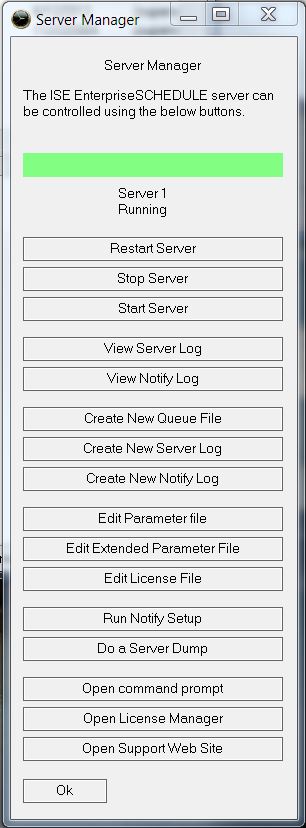The Windows Server Manager can be used to perform basic Server functions such as startng and stopping the server, viewing the server log, editing server parameters and configuring the Windows Notifications.
Note: The Server Manager can only be used to manage Windows Servers running EnterpriseSCHEDULE.

Function |
Description |
Restart Server |
Click to restart the EnterpriseSCHEDULE service for the group number chosen. |
Stop Server |
Click to stop the EnterpriseSCHEDULE service for the group number chosen. |
Start Server |
Click to start the EnterpriseSCHEDULE service for the group number chosen. |
View Server Log |
View the Server log file for the local server |
View Notify Log |
View the Notify Log for the Local server |
Create New Queue File |
Create a new Queue file for the local server. The queue file contains all state information for the current jobs and requires a server restart. |
Create New Server Log |
Create a new server log file for the local server |
Create New Notify Log |
Create a new Job Notifications log for the local server |
Edit Parameter File |
Edit the parameter file to configure the local server. |
Edit Extended Parameter File |
Edit the Extended Parameter file used to configure Node and IP setting for frequently accessed nodes. |
Edit License File |
Edit the License file for the local server |
Run Notify Setup |
Run the Notify setup utility to configure the SMTP server for job notifications. |
Do a Server Dump |
Dump server data for debugging server issues |
Open Command Prompt |
Open the DOS command prompt interface for EnterpriseSCHEDULE |
Open License Manager |
Open the ISE License Manager utility |
Open Support Web Site |
Open's the ISE Support Site in a browser. |